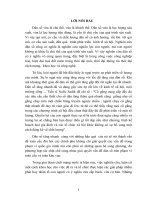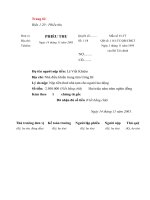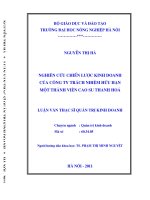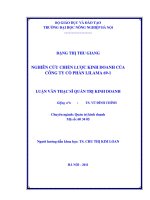Nghiên cứu chiến lược khích lệ được sử dụng bởi ban giám khảo trong hai chương trình truyền hình thực tế american idol 2010 và vietnam idol 2010
Bạn đang xem bản rút gọn của tài liệu. Xem và tải ngay bản đầy đủ của tài liệu tại đây (567.93 KB, 56 trang )
VIETNAM NATIONAL UNIVERSITY, HANOI
UNIVERSITY OF LANGUAGES AND INTERNATIONAL STUDIES
FACULTY OF ENGLISH LANGUAGE TEACHER EDUCATION
GRADUATION PAPER
ENCOURAGING STRATEGIES BY JUDGING
PANELS IN TWO REALITY SHOWS:
AMERICAN IDOL 2010 & VIETNAM IDOL 2010
Supervisor: Lại Thị Thanh Vân, M.A.
Student: Nguyễn Thị Nga
Class: 08.1.E14
HANOI - 2012
ĐẠI HỌC QUỐC GIA HÀ NỘI
TRƯỜNG ĐẠI HỌC NGOẠI NGỮ
KHOA SƯ PHẠM TIẾNG ANH
KHÓA LUẬN TỐT NGHIỆP
NGHIÊN CỨU CHIẾN LƯỢC KHÍCH LỆ ĐƯỢC
SỬ DỤNG BỞI BAN GIÁM KHẢO TRONG HAI
CHƯƠNG TRÌNH TRUYỀN HÌNH THỰC TẾ:
AMERICAN IDOL 2010 VÀ VIETNAM IDOL 2010
Giáo viên hướng dẫn: Lại Thị Thanh Vân
Sinh viên: Nguyễn Thị Nga
Khoá: 08.1.E14
HÀ NỘI - 2012
ACKNOWLEDGEMENTS
First and foremost, I would like to sincerely thank my supervisor, Ms Lai Thi
Thanh Van who suggested, commented, and guided me during the process of carrying out
this study. I would not be able to finish my study without receiving her enormous help.
Also, I would like to express my deep sense of gratitude to my friends at
University of Languages and International Studies for their encouragements.
Last but not least, I am grateful to my family, especially my brother, whose
support and encouragements did play such an important role in the success of my study.
Nguyen Thi Nga
ABSTRACT
This graduation paper is a study of cross cultural study of using verbal
encouraging strategies by judging panels in the two reality shows: American Idol 2010
and Vietnam Idol 2010. It aims to investigate:
1. What are the common strategies American & Vietnamese judging panels use to
express verbal encouragement to the candidates in American Idol 2010 & Vietnam
Idol 2010?
2. What are the similarities and differences in the ways American & Vietnamese
judging panels apply these strategies in the two reality shows?
The author carried out this research based on eight galas of the two favorite realty
shows: American Idol 2010 and Vietnam Idol 2010, which were all shown on television
as well as various internet sources. The encouraging utterances employed by American
and Vietnam panels were noted down and categorized into nine encouraging strategies.
The researcher then analyzed the collected data with the help of qualitative and
quantitative methods.
The results of the study show that encouragement is a complex speech act, which
is performed with a variety of strategies. Due to the data analysis, the author can
investigate some significant similarities as well as differences in the choices and
frequencies of use of these strategies by two groups: American and Vietnamese
examiners.
Hopefully, this study can be considered as a useful source of reference for related
researches in the future.
TABLE OF CONTENTS
Acknowledgements………………………………………………………………….…i
Abstract……………………………………………………………………...…...….... ii
Table of contents……………………………..…………………………..…………... iii
List of tables………………………………………………………………………..... vi
List of figures……………………………………………………...………….……. viii
PART A: INTRODUCTION………………………………………………………. 1
1. Statement of the problem and rationale for the study………………......... 1
2. Research aims and research questions……………………………………... 2
3. Significance of the study…………………………………………………….. 3
4. Scope of the study………………………………………………………….... 3
5. Organization……………………………………………………………......... 3
PART B: DEVELOPMENT………………………………………………….……. 5
Chapter 1: LITERATURE REVIEW……………………………………….……… 5
1.1.
Cross- cultural communication………………………………………........ 5
1.1.1. Culture …………………………………..…………………………..... 5
1.1.2. Communication ………..……………………………………………... 5
1.1.3. Cross cultural communication…………………………………….….. 9
1.2.
Speech acts…………………………………………………………….… 10
1.2.1. Definition of speech acts…………………………………………….. 10
1.2.2. Classifications of speech acts……………………………………….. 11
1.2.3. Encouraging as a speech act……………………………………..….. 13
1.3.
Reality shows………………………………………………………….... 14
1.3.1. Definition…………………………………………………………..... 14
1.3.2. Idols series…………………………………………………………... 15
Chapter 2: METHODOLOGY………………………………………………….... 17
2.1. Research design………………………………………………………..…… 17
2.1.1. Selection of subjects…………………………………………………..…….. 17
2.1.2. Methods of the study………………………………………………………... 17
2.1.3. Procedures of data collection…………………………………………….…. 18
2.1.4. Procedures of data analysis…………………………………………………. 18
2.2. Analytical Framework…………………………………………………….... 18
Chapter 3: FINDINGS AND DISCUSSION
3.1. Findings…………………………………………………………………... 24
3.2. Discussion……………………………………………………………….. 30
PART C: CONCLUSION…………………………………………………….... 42
1. Summary of findings……………………………………………………. 42
2. Implications …………………………………………………………….. 43
3. Limitations of the study………………………………………………… 44
4. Suggestions for further studies………………………………………… 45
REFERENCES……………………………………………………….……..…. 46
APPENDICES: Transcripts…..………………………………………….….… I
Appendix A: American Idol 2010………………………………............…. I
Appendix B: Vietnam Idol 2010……………………………………….….
XXX
LIST OF TABLES
Table
1.1:
The
five
general
functions
of
speech
acts
(following
Searle
1979)………………………………………………………………………...……….. 13
Table 3.1: Use of encouraging strategies by the American panel in American Idol 2010
…………………………………………………………………………………. 30
Table 3.2: Use of encouraging strategies by the Vietnamese panel in Vietnam Idol
2010………………………………………………………………………………….. 32
Table
3.3:
Use
of
strategy
1
by
American
panel
and
Vietnamese
panel………………………………………………………………….……………… 35
Table
3.4:
Use
of
strategy
2
by
American
panel
and
Vietnamese
panel…………………………………………………………………….…………… 35
Table
3.5:
Use
of
strategy
3
by
American
panel
and
Vietnamese
panel………………………………………………………………….……………… 36
Table
3.6:
Use
of
strategy
4
by
American
panel
and
Vietnamese
panel………………………………………………………………….……………… 36
Table
3.7:
Use
of
strategy
5
by
American
panel
and
Vietnamese
panel…………………………………………………………………….…………… 37
Table
3.8:
Use
of
strategy
6
by
American
panel
and
Vietnamese
panel……………………………………………………………………….………… 37
Table
3.9:
Use
of
strategy
7
by
American
panel
and
Vietnamese
panel…………………………………………………………………...…………….. 38
Table
3.10:
Use
of
strategy
8
by
American
panel
and
Vietnamese
panel……………………………………………………………………………...….. 38
Table
3.11:
Use
of
strategy
9
by
American
panel
and
Vietnamese
panel……………………………………………………………………...………….. 38
Table 3.12: Frequency of preferred encouraging strategies for American and Vietnamese
panels………………………………………………………………………………… 41
LIST OF FIGURES
Figure 1.1: Diagram of components of communication (Nguyen Quang, 2001:
9)…………………………………………………………………………………….... 7
Figure 3.1: Use of encouraging strategies by the American panel in American Idol
2010………………………………………………………………………………...... 30
Figure 3.2: Use of encouraging strategies by the Vietnamese panel in Vietnam Idol
2010………………………………………………………………………...……….. 33
Figure 3.3: Use of encouraging strategies by American panel and Vietnamese
panel……………………………………………...………………………………….. 34
PART A: INTRODUCTION
1. Statement of the problem and rationale for the study
It is widely believed that language is a popular and useful tool for human beings
in all societies. Different cultures have their own languages. Therefore, language helps
people not only communicate with each other but also acquire other communities’
cultures. In fact, the relationship between language and culture has been taken into
account by many researchers and linguists until now. There are many different opinions
around this issue; however, all arguments lead to a common point about the social
interaction between these two items. As Them (2000, p.1-19) said, language is a product
as well as an important part of culture. Similarly, this point is shared by Hudson (1981):
“As for the relation between language and culture, most of language is contained within
culture” and Goodenough (1957): “A society’s language is an aspect of its own
culture…The relation of language to culture is that of part to people”. Language and
culture are two factors playing important roles in communication. Once language is
combined with culture effectively, it is likely to establish a successful communication.
In communication, encouraging strategies which help people be confident are very
important. According to Fleishman, “most of us, swimming against the tides of trouble
the world knows nothing about, need only a bit of praise or encouragement - and we will
make the goal”. In fact, encouragement is really useful for people in any cases, even in
simple ones. For instance, children who have enthusiastic support from their parents may
learn better than others. Another example showing the necessity of encouragement is that
disabled people would have enough strength to cope with all difficulties they have to
encounter if they are supported by the whole society. Obviously, the role of
encouragement is undeniable. However, this point has not received as much attention
from Vietnamese researchers and linguists as it should be.
As mentioned above, encouragement plays an important role in a variety of
aspects of life. It is considered as a type of speech act common in both American and
Vietnamese cultures. This study only focuses on a specific situation in which the role of
encouraging strategies is also incontrovertible. It is in two reality shows named American
Idol 2010 and Vietnam Idol 2010. American Idol and Vietnam Idol are two reality shows
proving a popular attraction for audiences in both these countries. This study may help
viewers have a closer look into encouraging strategies employed in these two programs,
and the similarities as well as the differences in the ways American judging panels and
Vietnamese ones use to encourage the candidates if any. In addition, these findings
hopefully make positive contributions to the success in Vietnamese American crosscultural communication.
2. Research aims and research questions
This study aims to investigate common strategies employed by the American &
Vietnamese judging panels to verbally encourage the candidates in American Idol 2010
and Vietnam Idol 2010. Subsequently, the similarities as well as the differences in the
ways American & Vietnamese panels apply these encouraging strategies could be found
out. Additionally, this study is expected to contribute to provide for viewers, especially
Vietnamese ones who are interested in these two reality shows, a critical look into the
cultural factors leading to these differences. With a view to achieving the above aims of
the study, the research questions guiding the investigation are as follows:
3. What are the common strategies the American & Vietnamese judging panels use
to express verbal encouragement to the candidates in American Idol 2010 &
Vietnam Idol 2010?
4. What are the similarities and differences in the ways the American & Vietnamese
judging panels apply these strategies in the two reality shows?
3. Significance of the study
It is hoped that the findings of the study will contribute to provide a realistic look
into encouraging strategies used by the American and Vietnamese judging panels in the
two reality shows: American Idol 2010 and Vietnam Idol 2010. The study, therefore,
could identify potential distinctions between American and Vietnamese customs reflected
in their use of encouraging strategies in these two reality shows. Moreover, the study is
expected to strengthen the cross-cultural communication between people from the two
cultures: American culture and Vietnamese one.
4. Scope of the study
It is widely known that encouraging behaviors are reflected through both verbal
and nonverbal communication. This study, however, focuses only on verbal encouraging
strategies employed by the judging panels in these two reality shows. Nonverbal
communication (including paralinguistic and extra-linguistic factors) is not discussed in
this paper in spite of its considerable importance in real-life communication.
In addition, only judging panels in American Idol 2010 and Vietnam Idol 2010 are
within the scope of this study. Other elements such as audiences, candidates and other
versions of Idol are not taken into consideration in this study.
5. Organization
The study consists of 3 parts, each of which takes responsibility for a particular
function.
Part A: Introduction
This part presents the overview of the study including statement of the problem
and rationale for the study, research aims and research questions, significance, the scope
and the organization of the study.
Part B: Development
Chapter 1: Literature review
In chapter 1, all the terms as well as the key theoretical concepts that the study is
based on are clearly explicated so that the next parts of the study can be easily followed
by readers.
Chapter 2: Methodology
This chapter describes the participants and instruments of the study. Additionally,
the procedure applied for collecting and analyzing data for the study is introduced.
Chapter 3: Results and discussion
Chapter 3 presents the results of the study that the researcher investigates from the
collected data based on the two research questions. Besides, it provides a detailed
discussion about the employment of encouraging strategies by the judging panels in these
two reality shows.
Part C: Conclusion
A summary of the study, the major findings, the implications, the limitations as
well as suggestions for further studies are all mentioned in this final chapter.
PART B: DEVELOPMENT
CHAPTER 1: LITERATURE REVIEW
1.1. Cross-cultural communication
1.1.1. Culture
There is a variety of definition of culture from time to time. According to Levine
and Adelman (1993), culture is “a shared background (for example, national, ethnic,
religious) resulting from a common language and communication style, customs, beliefs,
attitudes and values”. In this definition, the researchers tend to emphasize the association
between language and communication to make a full culture. Similarly, Triandis (1994)
defines culture “as a set of human- made objective and subjective elements that in the
past have increases the probability of survival and resulted in satisfaction for the
participants in an ecological niche”.
Besides these ways of defining culture, Kluckhohm (in Clyne’s) hypothesizes:
“Culture is the patterned ways of thinking, feeling and reacting, required and transmitted
mainly by symbols, constituting the distinctive achievements of human groups, including
the embodiments of artifacts; the essential core of culture consists traditional ( i.e.
historically derived and selected) ideas and especially their attached values. (Cited in
Thanh & Trang, 2006, p.4)
Within the limitation of the paper, the definition which seems to be the simplest
one of all is Ferrando’s. He says that “culture is everything that people have, think or do
as a member of a society”. (Cited in Nguyen Quang’s lectures notes)
1.1.2. Communication
Communication is an integral factor in all spheres of life. It is an effective tool
helping people share all beliefs, values, ideas and feelings with each other.
Communication, therefore, is very familiar with human beings. However, it seems to be
quite difficult to find out the only definition for it. Up to present, there are hundreds of
definitions of communication. Linguists, based on different features of communication,
try to give their own distinct ones.
As defined by Beisler (1997), communication is “the transmission from one
person to another of a message which is understood by the receiver as the sender
intended”. In other words, communication, which is a process including three factors: a
sender, a message, and an intended receiver, is actually the activity of conveying
meaningful information.
Also regarding communication as a process, Samovar, Potter and McDaniel (2007:
12) define communication as “the process through which symbols are transmitted for the
purpose of eliciting a response”. From this definition, these researchers tend to focus on
the hearers’ response as well as the means of communication- the common system of
symbols. This is the same opinion as Alder and Rodman (1997: 3) when they mention
communication as “the process of human beings responding to the symbolic behavior of
other persons”.
A little bit different from other researchers, Berko (1989) pays more attention to
features of human communication. He defines:
“The process of communication is a conscious or unconscious, intentional or
unintentional one in which feelings and ideas are expressed in verbal and nonverbal
messages. It occurs in intrapersonal, interpersonal, and public levels. Human
communication is dynamic, continuous, irreversible, interactive and contextual”.
According to him, the process of human communication is a complex one which is
reflected in a variety of different characteristics. Even if people interact with each other
by verbal or nonverbal ways, it is necessary for communicators to be fully aware of the
typical nature of communication.
Nguyen Quang also gives a chart of communication and its system as follows:
COMMUNICATION
Verbal communication
Nonverbal communication
Intralanguage
Paralanguage
-Vocabulary
-Vocal characteristics
-Grammatical rules
+ Pitch
-Phonetic rules
+ Volume
-Rules of language use
+Rate
-…
+ Vocal quality
Extralanguage
+ Types of vocal flow
-Vocal interferences
-
-Silence
-...
Body language
(Action)
Object language
(Artifact)
Environmental
language
-Eye contact
-Clothing
-Setting
-Facial expression
-Jewellery
-Gestures
-Make- up
-Conversational
distance/
proxemics
-Touch/Haptics/Tactile
-Artificial scents
-Time/Chronemics
-…
-Flowers
-Lighting system
-Gifts
-Colour
-…..
- ….
Figure 1.1: Diagram of components of communication (Nguyen Quang, 2001: 9)
-…
-Heat
-…
It can be inferred clearly from the chart, communication has various functions and
implications. Through communication, people can reveal their own identities, attract
others or cooperate with them. As in the Oxford Dictionary, communication means “to
have a common door with”. Therefore, people communicate as a daily need for human
beings.
In conclusion, although there are many different arguments among linguists about
the definition of communication, it is still an integral need for human beings in real life. It
may be the reason why William gives a statement that “communication may not save us,
but without communication we will not be saved”. (Cited in Samanta, 1993: 1)
1.1.3. Cross-cultural communication
As is mentioned from the previous parts, culture and communication are two
interactive factors. Different countries have different cultures. When having a meeting
between two different cultures, it is likely to cause some serious problems. It is the reason
why the term “cross cultural communication” exists in our life.
Kramsch (1998) defines cross cultural communication as “the meeting of two
cultures or two languages across the political boundaries of nation- states”.
Besides, according to Longman Dictionary of Language Teaching and Applied
Linguistics, cross cultural communication can be seen as “an exchange of ideas,
information, etc. between people from different background”. (1992: 92)
Another definition is that “cross- cultural communication involves interaction
between people whose cultural perceptions and symbols systems are distinct enough to
alter the communication event.” (Samovar, 2007)
Levine and Adelman (1993: 94) imply “cross cultural communication is
communication (verbal and nonverbal) between people from different cultures;
communication that is influenced by cultural values, attitudes and behavior; the influence
of culture on people’s reactions and responses to each other”.
It is understandable from these definitions that culture shapes communication and
ways of interpreting communication. Once cross cultural communication happens, many
misunderstandings
or
communication
failures
may
happen
due
to
different
communicating styles or different background knowledge.
1.2. Speech acts
1.2.1. Definition of speech acts
Speech act is a technical term in linguistics and the philosophy of language. The
concept of speech acts was originated by the Oxford philosopher J.L. Austin in the 1930s
and then was developed in his famous book entitled “How to do things with words”
published in 1962. Up to now, it has been widely discussed by many philosophers and
linguists such as Hymes (1964), Searle (1969), Leech (1983), Levinson (1983), Thomas
(1995) and Yule (1996). Although there are many different ways to define speech acts,
these theorists have a point of view in common. It is the confirmation of the close
relationship between speech acts and language functions.
According to Searle (1969: 1), speech acts are “the basic or minimal units of
linguistic communication” and “those verbal acts such as promising, threatening and
requesting that one performs in speaking”. Specifically, in English, there are more labels
of speech acts such as apology, complaint, complement, encouragement, invitation,
promise or request. It is believed that when people use their language to express their
ideas, they also perform certain acts. For example, when one says “I will try my best to
be at home for dinner”, his/ her utterance is more than just a statement. It also aims to
perform the act of promising.
Similarly, a speech act, in Richards’ (1992: 342) opinion, is “an utterance as a
functional unit in communication”. In other words, during the process of communication,
“people not only produce utterances containing grammatical structures and words, they
perform actions via those utterances” (George Yule, 1997).
As for Austin (1962), there are three distinct but interrelated levels of action
beyond the act of utterance itself including a locutionary act, illocutionary act, and
perlocutionary act.
A locutionary act is the act of saying something that makes sense and reference
in the language. For example, the utterance “You should buy that house” is a
locutionary act because the hearer understands the content of this statement as
well as the house mentioned here.
An illocutionary act is the function of the utterance, performed with an
intention. For instance, the utterance “I swear to give it back next time” is used
to perform illocutionary act of promising.
A perlocutionary act is the results or effects that are produced by means of
saying something. For example, when one says “It is cold here”, the hearer
may close the windows or turn on the air conditioner.
Of all these three dimensions, the illocutionary act is the most discussed.
1.2.2. Classifications of speech acts
There are many differences in the ways philosophers and linguists classify speech
acts.
1.2.2.1. Function-based approach
According to Austin (1962: 151), based on the ways speakers realize their
intentions in speaking, there are five main types of speech acts as follow:
Verdictives: grade, estimate, diagnose…
Excertives: order, advise, warn…
Commissive: promise, bet, guarantee…
Behabitives: bless, apologize, criticize…
Explositives: argue, concede…
As for Searle (1983: 240), he draws attentions to how listeners respond to
utterance. His classification includes five categories:
Representatives: describe or state events. They can be assertion,
description, report, statement…
Directives: get the listeners to take a particular action. They can be
requests, commands, suggestions, orders…
Commissives: commit a speaker to do some action in the future. They can
be promises, threats…
Expressives: express the speaker’s attitudes and emotions toward
something. They can be excuses, thanks, congratulations…
Declaratives: change state of affairs in the world. They can be naming,
hiring, resignation…
Supporting Searle’s classification, Yule (1996: 55) summarizes the five types of
speech acts with the key features as below:
Speech act type
Direction of fit
S= speaker, X= situation
Declarations
Words change the word
S causes X
Representatives
Makes words fit the world
S believes X
Expressives
Makes words fit the world
S feels X
Directives
Makes the world fit words
S wants X
Commissives
Makes the world fit words
S intends X
Table 1.1: The five general functions of speech acts (following Searle 1979)
1.2.2.2. Structure-function based approach
Speech acts are also classified into direct and indirect ones based on the
relationship between structures and functions of speech acts. According to Yule (1996:
54), we have a direct speech act when a direct relationship between a structure and a
function exists, and we have an indirect one if there is not a direct relationship between a
structure and a function. For example, the utterance “It is cold here” can be seen as a
direct speech act if it is just used to make a statement about the temperature in one room,
and it can function as an indirect speech act if the speaker’s intention is to request the
hearer to close the window.
1.2.3. Encouraging as a speech act
Encouragement is a universal act which is not a new term for many scholars all
over the world.
As found in Oxford Advanced Learner’s Dictionary of English, “to encourage is to
give somebody support, courage or hope”.
According to Macmillan Dictionary, similarly, encouragement is defined as
“words or actions that give someone confidence or hope”.
In accordance with the classification of speech acts from Searle, encouragement
can be expressed in the expressive form. For example:
-
Well done!
-
Great work!
Also, encouragement can be classified as a representative:
-
You’ve clearly got talent!
-
I can see no reason why you won’t become a famous singer.
In addition, encouragement can be considered as a directive type of speech act.
For instance:
-
Take it easy!
-
Don’t give up!
Last but not least, encouragement also can be expressed in the commissive form as
follows:
-
I will vote for you.
In conclusion, encouraging can be seen as a complex type of speech act which
occupies four of five types of speech acts classified by Searle (1983: 240) & Yule (1996:
55).
1.3. Reality shows
1.3.1. Definition
Based on Wikipedia, a reality television is “a genre of television programming that
presents purportedly unscripted dramatic or humorous situations, documents actual
events, and usually features ordinary people instead of professional actors, sometimes in
a contest or other situation where a prize is awarded”.
In the Free Dictionary ( a reality
television is defined as a “television show in which members of the public or celebrities
are filmed living their everyday lives or undertaking specific challenges”.
According to Collins Cobuild English Dictionary for Advanced Learners, “a
reality show is a type of television programming that aims to show how ordinary people
behave in everyday life, or in situations, often created by program makers, which are
intended to present everyday life”. Generally speaking, this definition is likely to be the
most exact and easily understandable one of all.
1.3.2. Idol series
1.3.2.1.
Definition
Idol is a reality television singing competition to find out a new musical star. The
show was created by Simon Fuller, and combined many elements previously used by
other shows such as Pop Stars. In this reality show, audience plays an important role in
choosing the winner of the competition. Nowadays, Idol has become popular and beloved
in many countries including Vietnam.
1.3.2.2.
Format description
The format of the show is mainly based on the British show Pop Idol, which was
in turn inspired by Pop Stars. The final round of Idol takes place in 10 weeks. In each
week, contestants will have to choose the songs freely or as being required by the rules of
the show. During the show, candidates having the highest number of votes will not be
informed. Only the candidates having the lowest ones in each night are named and
eliminated.
1.3.2.3.
Judging
At the end of the performance of each contestant in the show each night, a panel of
experts will give comments on the performance of contestants.
As for American Idol 2010, the judging panel consists of A&R executive Simon
Cowell, singer-song writer Kara Elizabeth DioGuardi, television host and actress Ellen
Lee DeGeneres, and singer Randy Jackson.









